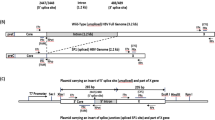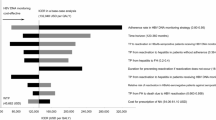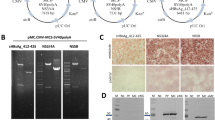Abstract
Electroporation (EP)-mediated DNA immunization can elicit effective immune responses in a variety of animals, and is widely used in research studies and clinical trials. However, high-pulse voltage, high DNA dose and multiple immunizations are still required to achieve considerable immune responses. To further improve the efficiency of EP-mediated DNA immunization, many parameters have been tried and optimized in recent years. In our early research, we found that the short noncoding DNA fragments (sf-DNA) can significantly enhance EP-mediated transgene expression of reporter genes. In this study, we tested the effect of sf-DNA on the immune potency of EP-mediated hepatitis B virus (HBV) DNA vaccination in a mouse model. The results show that the use of sf-DNA in EP-mediated HBV DNA vaccination leads to an enhanced expression of the HBV surface antigen, resulting in higher cellular and humoral responses. Furthermore, the immune responses in the sf-DNA-mediated 120 V cm−1 EP immunization group were higher than that of the 200 V cm−1 EP without sf-DNA groups. These data suggest that the sf-DNA can be used as an effective helper molecule to improve the immune response of EP-mediated HBV DNA vaccination, which may make the EP-mediated DNA vaccination more effective and suitable for animal and clinical application.
This is a preview of subscription content, access via your institution
Access options
Subscribe to this journal
Receive 6 print issues and online access
$259.00 per year
only $43.17 per issue
Buy this article
- Purchase on SpringerLink
- Instant access to full article PDF
Prices may be subject to local taxes which are calculated during checkout




Similar content being viewed by others
References
Robinson HL, Torres CA . DNA vaccines. Semin Immunol 1997; 9: 271–283.
Robinson HL . DNA vaccines: basic mechanism and immune responses (Review). Int J Mol Med 1999; 4: 549–555.
Gurunathan S, Klinman DM, Seder RA . DNA vaccines: immunology, application, and optimization. Annu Rev Immunol 2000; 18: 927–974.
Lehmann-Grube F, Lohler J, Utermohlen O, Gegin C . Antiviral immune responses of lymphocytic choriomeningitis virus-infected mice lacking CD8+ T lymphocytes because of disruption of the beta 2-microglobulin gene. J Virol 1993; 67: 332–339.
Calarota S, Bratt G, Nordlund S, Hinkula J, Leandersson AC, Sandstrom E et al. Cellular cytotoxic response induced by DNA vaccination in HIV-1-infected patients. Lancet 1998; 351: 1320–1325.
Wang R, Doolan DL, Le TP, Hedstrom RC, Coonan KM, Charoenvit Y et al. Induction of antigen-specific cytotoxic T lymphocytes in humans by a malaria DNA vaccine. Science 1998; 282: 476–480.
Hokey DA, Weiner DB . DNA vaccines for HIV: challenges and opportunities. Springer Semin Immunopathol 2006; 28: 267–279.
Ulmer JB, DeWitt CM, Chastain M, Friedman A, Donnelly JJ, McClements WL et al. Enhancement of DNA vaccine potency using conventional aluminum adjuvants. Vaccine 1999; 18: 18–28.
Hung CF, Wu TC . Improving DNA vaccine potency via modification of professional antigen presenting cells. Curr Opin Mol Ther 2003; 5: 20–24.
Cui FD, Asada H, Jin ML, Kishida T, Shin-Ya M, Nakaya T et al. Cytokine genetic adjuvant facilitates prophylactic intravascular DNA vaccine against acute and latent herpes simplex virus infection in mice. Gene Ther 2005; 12: 160–168.
Foldvari M, Babiuk S, Badea I . DNA delivery for vaccination and therapeutics through the skin. Curr Drug Deliv 2006; 3: 17–28.
Lima KM, Santos SA, Lima VM, Coelho-Castelo AA, Rodrigues Jr JM, Silva CL . Single dose of a vaccine based on DNA encoding mycobacterial hsp65 protein plus TDM-loaded PLGA microspheres protects mice against a virulent strain of Mycobacterium tuberculosis. Gene Ther 2003; 10: 678–685.
Yoshida A, Nagata T, Uchijima M, Higashi T, Koide Y . Advantage of gene gun-mediated over intramuscular inoculation of plasmid DNA vaccine in reproducible induction of specific immune responses. Vaccine 2000; 18: 1725–1729.
Frelin L, Alheim M, Chen A, Soderholm J, Rozell B, Barnfield C et al. Low dose and gene gun immunization with a hepatitis C virus nonstructural (NS) 3 DNA-based vaccine containing NS4A inhibit NS3/4A-expressing tumors in vivo. Gene Ther 2003; 10: 686–699.
Sheyn D, Kimelman-Bleich N, Pelled G, Zilberman Y, Gazit D, Gazit Z . Ultrasound-based nonviral gene delivery induces bone formation in vivo. Gene Ther 2008; 15: 257–266.
Babiuk S, Baca-Estrada ME, Foldvari M, Baizer L, Stout R, Storms M et al. Needle-free topical electroporation improves gene expression from plasmids administered in porcine skin. Mol Ther 2003; 8: 992–998.
Otten G, Schaefer M, Doe B, Liu H, Srivastava I, zur Megede J et al. Enhancement of DNA vaccine potency in rhesus macaques by electroporation. Vaccine 2004; 22: 2489–2493.
Zhao YG, Xu Y . Electroporation-mediated HBV DNA vaccination in primate models. Methods Mol Biol 2008; 423: 487–495.
Gehl J . Electroporation: theory and methods, perspectives for drug delivery, gene therapy and research. Acta Physiol Scand 2003; 177: 437–447.
Heller LC, Heller R . In vivo electroporation for gene therapy. Hum Gene Ther 2006; 17: 890–897.
Tsang C, Babiuk S, van Drunen Littel-van den Hurk S, Babiuk LA, Griebel P . A single DNA immunization in combination with electroporation prolongs the primary immune response and maintains immune memory for six months. Vaccine 2007; 25: 5485–5494.
Liu KH, Ascenzi MA, Bellezza CA, Bezuidenhout AJ, Cote PJ, Gonzalez-Aseguinolaza G et al. Electroporation enhances immunogenicity of a DNA vaccine expressing woodchuck hepatitis virus surface antigen in woodchucks. J Virol 2011; 85: 4853–4862.
Cristillo AD, Weiss D, Hudacik L, Restrepo S, Galmin L, Suschak J et al. Persistent antibody and T cell responses induced by HIV-1 DNA vaccine delivered by electroporation. Biochem Biophys Res Commun 2008; 366: 29–35.
Daud AI, DeConti RC, Andrews S, Urbas P, Riker AI, Sondak VK et al. Phase I trial of interleukin-12 plasmid electroporation in patients with metastatic melanoma. J Clin Oncol 2008; 26: 5896–5903.
Chiarella P, Fazio VM, Signori E . Application of electroporation in DNA vaccination protocols. Curr Gene Ther 2010; 10: 281–286.
Zhao YG, Peng B, Deng H, Chen G, Yang F, Shao M et al. Anti-HBV immune responses in rhesus macaques elicited by electroporation mediated DNA vaccination. Vaccine 2006; 24: 897–903.
Yin J, Dai A, Lecureux J, Arango T, Kutzler MA, Yan J et al. High antibody and cellular responses induced to HIV-1 clade C envelope following DNA vaccines delivered by electroporation. Vaccine 2010; 29: 6763–6770.
Babiuk S, Baca-Estrada ME, Foldvari M, Storms M, Rabussay D, Widera G et al. Electroporation improves the efficacy of DNA vaccines in large animals. Vaccine 2002; 20: 3399–3408.
Hirao LA, Wu L, Khan AS, Hokey DA, Yan J, Dai A et al. Combined effects of IL-12 and electroporation enhances the potency of DNA vaccination in macaques. Vaccine 2008; 26: 3112–3120.
Peng J, Zhao Y, Mai J, Guo W, Xu Y . Short noncoding DNA fragment improve efficiencies of in vivo electroporation-mediated gene transfer. J Gene Med 2012; 14: 563–569.
Babiuk S, Tsang C, van Drunen Littel-van den Hurk S, Babiuk LA, Griebel PJ . A single HBsAg DNA vaccination in combination with electroporation elicits long-term antibody responses in sheep. Bioelectrochemistry 2007; 70: 269–274.
van Drunen Littel-van den Hurk S, Luxembourg A, Ellefsen B, Wilson D, Ubach A, Hannaman D et al. Electroporation-based DNA transfer enhances gene expression and immune responses to DNA vaccines in cattle. Vaccine 2008; 26: 5503–5509.
Martinon F, Kaldma K, Sikut R, Culina S, Romain G, Tuomela M et al. Persistent immune responses induced by a human immunodeficiency virus DNA vaccine delivered in association with electroporation in the skin of nonhuman primates. Hum Gene Ther 2009; 20: 1291–1307.
Babiuk S, Baca-Estrada ME, Foldvari M, Middleton DM, Rabussay D, Widera G et al. Increased gene expression and inflammatory cell infiltration caused by electroporation are both important for improving the efficacy of DNA vaccines. J Biotechnol 2004; 110: 1–10.
Chiarella P, Massi E, De Robertis M, Sibilio A, Parrella P, Fazio VM et al. Electroporation of skeletal muscle induces danger signal release and antigen-presenting cell recruitment independently of DNA vaccine administration. Expert Opin Biol Ther 2008; 8: 1645–1657.
Dolter KE, Evans CF, Ellefsen B, Song J, Boente-Carrera M, Vittorino R et al. Immunogenicity, safety, biodistribution and persistence of ADVAX, a prophylactic DNA vaccine for HIV-1, delivered by in vivo electroporation. Vaccine 2011; 29: 795–803.
Nicol F, Wong M, MacLaughlin FC, Perrard J, Wilson E, Nordstrom JL et al. Poly-L-glutamate, an anionic polymer, enhances transgene expression for plasmids delivered by intramuscular injection with in vivo electroporation. Gene Ther 2002; 9: 1351–1358.
Peng B, Zhao Y, Lu H, Pang W, Xu Y . In vivo plasmid DNA electroporation resulted in transfection of satellite cells and lasting transgene expression in regenerated muscle fibers. Biochem Biophys Res Commun 2005; 338: 1490–1498.
Yewdell JW, Bennink JR . Immunodominance in major histocompatibility complex class I-restricted T lymphocyte responses. Annu Rev Immunol 1999; 17: 51–88.
Krieg AM, Yi AK, Matson S, Waldschmidt TJ, Bishop GA, Teasdale R et al. CpG motifs in bacterial DNA trigger direct B-cell activation. Nature 1995; 374: 546–549.
Pasquini S, Xiang Z, Wang Y, He Z, Deng H, Blaszczyk-Thurin M, Ertl HCJ . Cytokines and costimulatory molecules as genetic adjuvants. Immunol Cell Biol 1997; 75: 397–401.
He X, Chen G, Huang Y, Yang F, Wu L, Mo G . Construction and identification of therapeutic double-plasmid HBV DNA vaccine. Med J Chin PLA 2003; 28: 493–496.
Acknowledgements
This study was supported by Chinese Natural Science Foundation (grant no. 30801446).
Author information
Authors and Affiliations
Corresponding author
Ethics declarations
Competing interests
The authors declare no conflict of interest.
Rights and permissions
About this article
Cite this article
Peng, J., Shi, S., Yang, Z. et al. Short noncoding DNA fragments improve the immune potency of electroporation-mediated HBV DNA vaccination. Gene Ther 21, 703–708 (2014). https://doi.org/10.1038/gt.2014.44
Received:
Revised:
Accepted:
Published:
Issue date:
DOI: https://doi.org/10.1038/gt.2014.44



